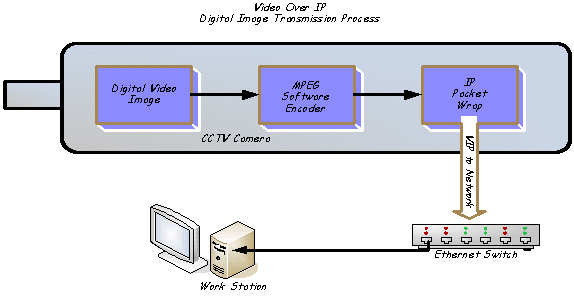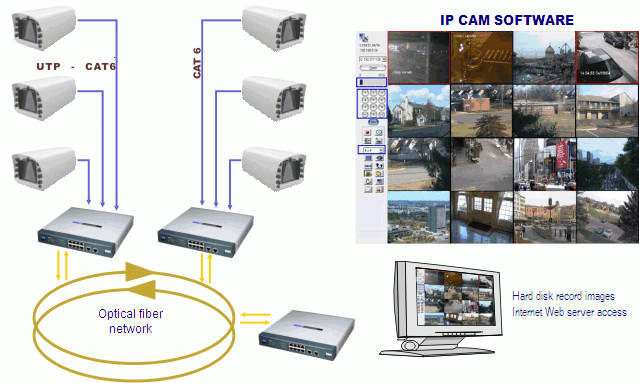Secure Your Home with CCTV Fiber Technology: Here Is
Wiki Article
Just How CCTV Cameras With Fiber Optic Result Enhance Long-Distance Monitoring
CCTV electronic cameras outfitted with fiber optic outcome represent a significant innovation in long-distance monitoring innovation, providing unparalleled advantages over conventional systems. By leveraging the homes of light transmission via fiber optics, these electronic cameras ensure high-definition video quality continues to be intact throughout substantial distances while properly alleviating electromagnetic disturbance - cctv fibre optic cable.
Understanding Fiber Optic Technology
Fiber optic modern technology is significantly made use of in long-distance tracking applications due to its remarkable capacity for information transmission. This innovation employs thin strands of glass or plastic fibers to transmit information as light signals, substantially decreasing the attenuation generally connected with conventional copper cables. The integral buildings of fiber optics allow for the transmission of huge volumes of data over substantial ranges without loss of high quality, making it a perfect choice for applications calling for reputable communication.The concept of total interior reflection assists in the efficient transmission of light within the fiber, making certain high bandwidth and rate. Unlike electrical signals in metal cables, optical fiber are unsusceptible to electromagnetic disturbance, enhancing the honesty of data transmission. This characteristic is particularly useful in environments with high levels of electric noise, such as industrial setups or urban areas.
In addition, fiber optic cables are lighter and a lot more adaptable than their copper counterparts, which streamlines setup and lowers structural tons. With their durability and resistance to environmental aspects, optical fiber are well-suited for outside applications, therefore extending the reach of checking systems. Therefore, fiber optic technology is coming to be a keystone in contemporary security solutions, properly addressing the difficulties of long-distance tracking.
Advantages of Fiber Optic CCTV
Making use of fiber optic modern technology in CCTV systems offers numerous benefits that enhance surveillance capabilities. One of the main benefits is the capability to transfer high-def video clip over fars away without considerable signal destruction. Unlike conventional copper cables, fiber optics can maintain video clip high quality over substantial runs, making them excellent for huge homes or remote tracking locations.Additionally, fiber optic cables are less at risk to electromagnetic disturbance, which can misshape signals in conventional systems. This makes certain more clear pictures and undisturbed service, vital for safety tracking. Moreover, fiber optics are inherently extra safe, as obstructing signals requires specialized tools, therefore offering an added layer of defense against unauthorized accessibility.
The light-weight and small nature of fiber optic cables additionally simplifies installment, enabling easier transmitting through limited spaces and lowering general labor prices. Their longevity makes them resistant to ecological elements such as dampness and temperature variations, extending the lifespan of the security system.
Finally, fiber optic systems can support a higher number of cameras on a solitary network, optimizing resources and supplying scalability for future expansion. These advantages make fiber optic CCTV systems a superior option for modern-day security demands.
Comparison With Typical Systems
When comparing CCTV systems, standard setups usually drop short in numerous essential areas, particularly in regards to range and signal integrity. Conventional coax systems normally face considerable signal destruction over long ranges, restricting efficient tracking ranges to about 300 feet (cctv fibre optic cable). Yet limit, photo quality diminishes, resulting in prospective blind areas and lowered security performanceIn contrast, fiber optic systems maintain signal stability over much higher ranges, commonly going beyond numerous miles without loss of top quality. This is largely due to their ability to transmit information as light signals, which are much less vulnerable to electromagnetic interference than electrical signals used in conventional systems.
Additionally, conventional systems require more comprehensive maintenance and troubleshooting due to their susceptability to ecological aspects such as wetness and electromagnetic noise. Fiber optic systems, on the other hand, offer enhanced resilience and lower upkeep expenses, as they are less prone to damages.
Applications in Long-Distance Surveillance
The advantages of modern CCTV systems in maintaining signal honesty over cross countries open up a large range of applications for long-distance surveillance. One considerable application is in city security, where communities deploy fiber optic CCTV systems to check public areas, enhancing safety and security and preventing criminal activity. These systems provide continual, high-quality video clip feeds that are essential for effective police and emergency response.An additional important application remains in commercial settings, where remote surveillance of manufacturing procedures and harmful locations is essential. Fiber optic CCTV can hold up against extreme environments and send data over long ranges without loss of quality, enabling real-time oversight and lessening dangers to personnel.
Additionally, important framework such as airport terminals, trains, and pipelines gain from long-distance CCTV tracking. Protection teams can supervise big locations from systematized control rooms, guaranteeing fast action to any kind of incidents.
Additionally, in farming setups, farmers utilize long-distance CCTV to keep track of crops and livestock, assisting to improve efficiency and protection. On the whole, the versatility and reliability of fiber optic CCTV systems make them important throughout different markets, making it possible for comprehensive surveillance solutions tailored to particular needs.
Future Trends in Surveillance Technology
How will advancements in technology reshape the landscape of security? The future of security modern technology is positioned for substantial change, driven by technologies such as artificial intelligence (AI), maker understanding, and side computer. These modern technologies make it possible for real-time information evaluation, enabling rapid recognition of possible hazards and enhanced fiber optic security camera situational recognition.AI-powered analytics will improve the precision of face acknowledgment systems, decreasing incorrect positives and enabling much more efficient tracking of people. In addition, the integration of Internet of Points (IoT) gadgets will certainly assist in a seamless network of interconnected surveillance systems, improving monitoring capacities across vast locations.
Another pattern is the change towards cloud-based storage remedies, which offer scalable information administration and ease of access. This will allow organizations to save vast amounts of video clip data without the restrictions of physical storage space, while making sure that information is easily retrievable.

Conclusion
In verdict, CCTV cameras outfitted discover here with fiber optic output stand for a substantial development in long-distance surveillance capabilities. The use of fiber optic innovation guarantees high-definition video transmission over substantial ranges without quality deterioration, while additionally providing immunity to electromagnetic disturbance. The light-weight and flexible nature of these systems helps with structured installment and source optimization. As surveillance technology proceeds to advance, the fostering of fiber optic solutions will likely play a critical function in improving protection throughout diverse applications.Report this wiki page